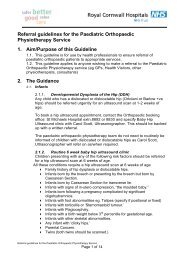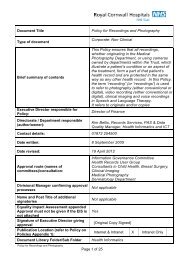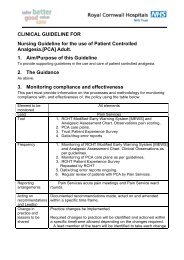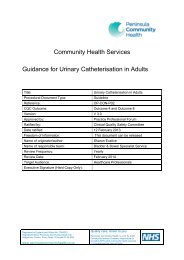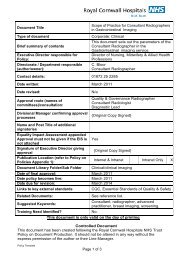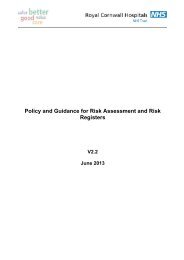Incident Management Policy Including Serious Incidents Requiring ...
Incident Management Policy Including Serious Incidents Requiring ...
Incident Management Policy Including Serious Incidents Requiring ...
You also want an ePaper? Increase the reach of your titles
YUMPU automatically turns print PDFs into web optimized ePapers that Google loves.
No harm/minimal harmAny immediate actionsnecessary. Ensure DATIXincident report completed.Report to external agencies asrequired.Investigation at local level byimmediate manager/ supervisor.Learning shared acrossorganisation as appropriateModerate/severe harmAny immediate actionsnecessary. Ensure DATIXincident report completed.Consider need to report as SUIReport to external agencies asrequired.Investigation within departmentby manager/ supervisor, possiblywith input from local managersand/or ‘specialists’ from otherteams.DeathAny immediate actions necessary.Report on DATIX immediately,internally and to external agenciesas required, including reporting asa significant untoward incident(section 6) if appropriate.n Investigation and root causeanalysis by Manager involvingspecialists as appropriate.Report outcomes to Directorresponsible for area and learningshared across organisation asappropriate.5.2 RecordsContemporaneous records must be made throughout the incident management processand investigation should take place as soon as possible after the events to ensure recall isas accurate as possible.5.3 TimescalesDATIX has a timeframe built into the system based on blocks of 7 days for any part of theprocess e.g. report to investigation commencing, completion of investigation, approval andclosure. Where the activity goes past 7 days the system will mark the incident as overdue.Realistically all reports should be opened by the investigating manager as soon as possiblepreferably within 48 hours.5.4 Simple investigationsSimple investigations should be completed as near to the 7 day period as possible but it ismore important to have a thorough, proportionate and well conducted investigation eventough it goes over the seven days. Where it is not possible to complete the investigationwithin the 7 day period, the incident report should be update to make it clear why theinvestigation is ongoing and what actions are planned to bring it to conclusion.The collection and analysis of all facts surrounding the incident should be completed beforeany conclusions are made regarding the cause.It is important to focus on the true purpose of the investigation, that of learning andpreventing recurrence, Root Cause Analysis techniques can be used for all incidentinvestigations, and will be used for all amber and red incidents and SUIs, as an effectivemethod of focussing attention on learning.The <strong>Incident</strong> Decision Tree has been created by the NPSA (see references section) to helpNHS managers and senior clinicians decide whether they need to suspend (exclude) staffinvolved in a serious patient safety incident and to identify appropriate managementaction. The aim is to promote fair and consistent staff treatment within and betweenhealthcare organisations.The <strong>Incident</strong> Decision Tree is a web-based tool and is simple to use. Depending on thenature of the incident and the amount of information gathered, it usually takes 30 to 6010 of 28




